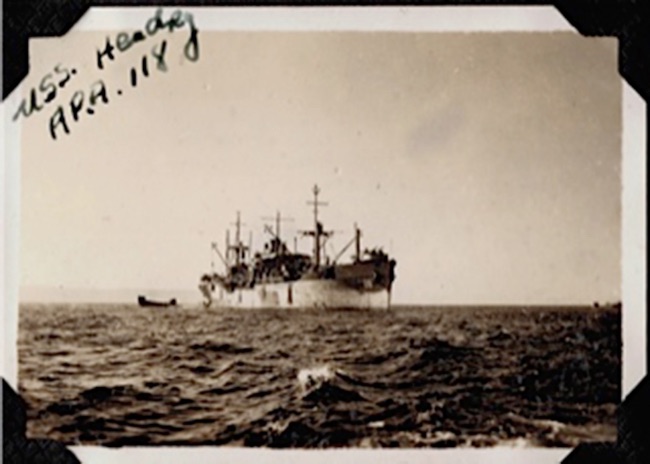This website is dedicated to the men of the USS Hendry, and the sacrifices they made during World War II. The Hendry has the distinction of being the first U.S. ship to sail into Nagoya, Japan (7 Oct 1945). The men of the Hendry were allowed to go ashore to trade with the inhabitants.
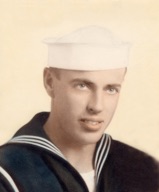
This site was created for former crew members and their relatives to share memories and photos. I have found no other site that pertains to the USS Hendry.
Additions are welcome!
We welcome Terri and Rick Hills and Terri’s late father SM3c Bryant Hobson Farlow Jr. Terri lost her father to Leukemia in 2003. She said, “my father fibbed about his age and entered World War II at the ripe old age of 17. He lost his only brother early in the war over France during a bombing mission. His brother was MIA for years. His brother was finally located and brought home to the US in the mid 1950s and buried in the Marietta National Cemetery. So World War II was always a topic of conversation in our home as I grew up. My dad never really talked to us much about his combat time but we heard many stories of his life on the USS Hendry.”
References
This article includes text from the public domain Dictionary of American Naval Fighting Ships.
Bryant Hobson Farlow Jr., SM3c
NC Division
External links
We welcome Mike Gorman and his grandfather, Walter Dawson Gorman S1c, who was a crew member of the USS Hendry. Mike, who calls his grandfather “Pop” sent me an email saying “although he’s 103, he’s still alive, well and ornery as ever.” Mike also sent along 3 photos from his grandfather’s collection. To the right is a picture of Mr. Gorman in uniform. All three photos can be viewed on the photos page of this site. We are honored to have Mr. Gorman as a visitor, and welcome him back on board again!
Walter Dawson Gorman, S1c
2nd Division


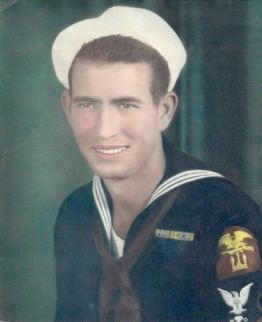
Albert Lee Dodd, MoM2c(T)
NC Division
We welcome Nelda and Chuck Agrusa and Nelda’s father MoM2c(T) Albert Lee Dodd. Nelda paid tribute to her father by saying, “Albert Lee Dodd left his wife and three young children in Healdton, Oklahoma, to join the Navy. He was on the maiden voyage of the USS Hendry and also on her last. He never talked about the war. We can only imagine the horror that all the young men witnessed then and what our young warriors are experiencing now.” Nelda also sent a photo of Albert at home while on leave. It is in the photos section of this site.
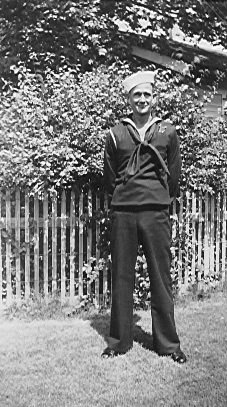
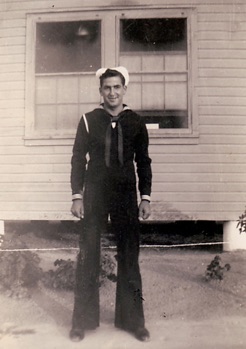
Patrick A. Petillo, GM2c
2nd Division
We welcome Gavin Petillo and his uncle GM2c Patrick A. Petillo aboard the USS Hendry website. Pat and his brother Joe, PFC Joseph J. (Red) Petillo, USMC, were in the service at the same time, and both were at the invasion of Okinawa. While a third brother, Angelo Petillo, was also serving in China. Pat was on the Hendry and Joe was a member of the First Marine Division. Joe was killed in action, 13 April 1945 by a Japanese sniper. Gavin said, “I never knew my uncle's ship the Hendry was in the (Okinawa) area (at the same time Joe was killed there).” Gavin sent us new photos for the Hendry site.
Wilbert Bartow "Buck" Maynard, Y2c
NC Division
We welcome George Irvin and his uncle YO2 Wilbert Bartow“Buck” Maynard aboard the USS Hendry website. Buck served on USS Hendry from shakedown to decommissioning. He was the Exec's Yeoman, Y2c. He was sound powered phone talker for the Captain in Iwo Jima and Okinawa. He is still living at 88 years of age in Clanton, Alabama. He is originally from Salado, Texas and lived many years in Eunice, Louisiana working for Transcontinental Gas Pipeline Co. He’s in poor health, but has a very good memory. George has been interviewing Buck by phone regarding his memory of the invasions. George is a 6 year Navy veteran himself...USS CORAL SEA CVA-43 and USS SHANGRI LA CVA-38. George said Buck is pumped about his Hendry memories.
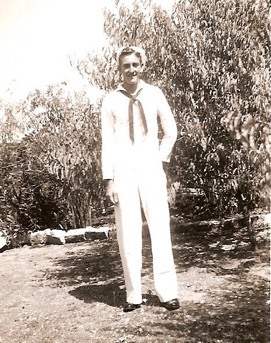
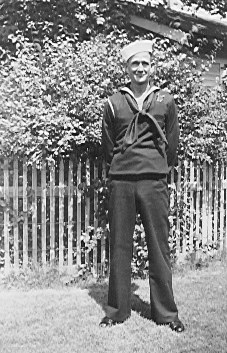

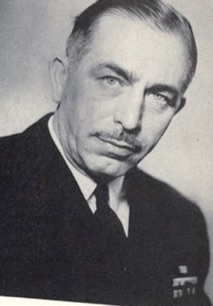
Edward Llewellyn Schleif, Captain, USS Hendry, 22 August 1945 - 21 February 1946.
1925 US Naval Academy graduate with a degree in Mechanical Engineering; 1933 Masters of Science and Masters of Arts Degrees from University of California, Berkeley. Served in World II and Korea. Born Apr 17,1902, Milwaukee, Wisconsin - Died May 11, 1965, San Buno California. Buried Golden Gate National Cemetery.
“Buck” Maynard’s memories and eye witness account of the USS Hendry at Iwo Jima and Okinawa
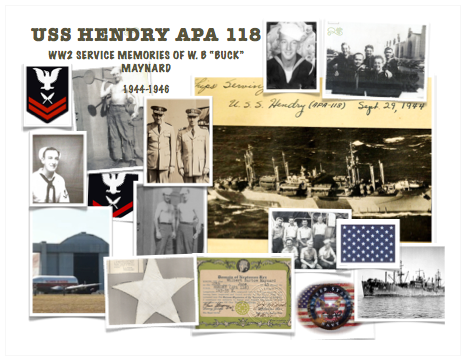
The author, George Wallace Irvin, is a former Navy Veteran, MM2 and lives in Texas. He served aboard the USS Coral Sea CVA-43 1959-1963 and the USS Shangri La CVA-38 1963-1965. The full 32 page Wilbert Bartow “Buck” Maynard Y2c Navy Memories 1944-1946 maybe viewed by contacting George Irvin @
George Wallace Irvin quote, “Buck is in poor health now and in the sunset years of his life, but his memory is good. I've attempted to capture his memories and eye witness observations during the invasions of Iwo Jima and Okinawa. I wish to God that I had done this many years ago. I've tried to collect his thoughts and the memories he has retained of his Navy days during WW2 for his descendants and anyone else who might have an interest. “
20 May 1943
Future Hendry Crewman W.B. “Buck” Maynard Graduates High School in Salado, Texas. I was one of those young men in high school when war was declared. My name is Wilbert Bartow Maynard. I've been known as "Buck" throughout my life. I was one of 12 siblings born May 8th of 1926 in the quaint Central Texas town of Salado. We grew up very poor, and I worked during my school days in farm fields, bailing hay, pulling corn, and other odd jobs to make money for school clothes. High School graduation required eleven years in those days. I turned 17 on May 8, 1943. When I graduated on May 20, 1943, I went to Freeport, Texas and got a job working for Stone & Webster Construction Company at Dow Chemical plant from May 1943 to Feb. 1944. I went to Houston and picked up papers to have my Dad sign for me so I could enlist in the U.S. Navy. He reluctantly agreed and signed my age waiver.

On Oct. 23, 1944
The USS Hendry left the United States for Pearl Harbor, Hawaii. The USS Hendry embarked the 111th Army at Pearl Harbor and transported them to Port Allen, Kauai, Hawaii where we immediately began extended amphibious training operations. We practiced disembarking and landing invasion troops on the beach day after day. It quickly dawned on us that some big naval operation was certainly in our future, but we had no clue just what it might be.
27 January 1945
USS Hendry leaves Pearl Harbor. This deployment was to Saipan that had been wrestled away from the Japanese to await the formation of the invasion convoy. We had the 14th, 24th, and other units of the 4th Marine Division for the Iwo Jima Invasion onboard, but we still did not know where the invasion was going to occur. Firefight skirmishes were still going on in the hills and jungles of Saipan with Jap stragglers. It was not uncommon for us to be watching movies onboard Hendry at anchor with shooting on Saipan going on.
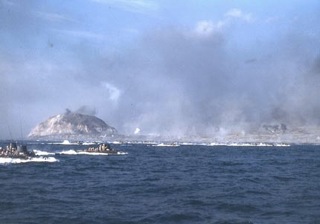
Iwo Jima seemed worthless to us, but did have three Japanese airfields. Those airfields were strategic to the allies who needed them for the attack on the Japanese mainland.
After days of aerial bombardment by American bombers, more than 450 ships amassed off Iwo Jima. At 0200 hours on 19 February 1945, the United States Navy took over the bombardment with their big guns from battle ships and cruisers. It was not known immediately that the naval bombardment was largely ineffective in softening the target because the Japs had moved deep into mountain tunnels in Mt. Suribachi. A ten day navel bombardment had been originally requested, but only three days were authorized.
At 0900 hours that morning of the invasion the first landings began with the 3rd, 4th, and 5th Marines. Big naval guns out at sea behind us were shooting projectiles over our ship and landing craft participating in disembarking troops and equipment. The USS Hendry disembarked the 14th, 24th, and other units of the 4th Marines.
Weather conditions Feb 19, 1945 on the first day of the invasion were almost ideal for the Marine assault landings. However, it turned bad on the second day with strong winds and a 4 foot surf. It was so bad that it disrupted the planned followup landings. The third day was no better, interfering with landing troops and supplies, but improved greatly on the fourth day. Then waves of troops came ashore with little resistance. The Japanese commander had decided to tactically hold fire until the beach was full of Marines and equipment to maximize their killing and destruction. When they were ashore in satisfactory numbers, "hell fire and brimstone" began to fall on them from higher elevations and with machine gunners and snipers firing from behind rusty hulks of merchant ships half sunken in the harbor.
As the invasion progressed, I could see figures (marines) falling on the beach. The Japanese held the high ground and had set up machine guns and snipers in those rusting hulks and were catching the marines in a brutal cross fire. All the while, those big naval guns farther out were firing 16" projectiles over the invasion ships, laying bombardment barrages on the Japs, and striking selected targets as directed by small aircraft flying overhead serving as fire control spotters. I recall seeing one such small spotter plane take a hit and smoke trailed from it. I was told that it landed on a small island near the action. I did not hear the fate of the pilot, but as the story went, the Japs would come out of hiding and move toward the plane on the beach only to be strafed by carrier fighter planes driving them back. This went on all day until dark. I never heard if that pilot survived or not, but I know our carrier pilots kept the Japs away from the plane at least in the daylight hours.
I recall viewing the beachhead through binoculars. I could see it was literally strewn with dead and wounded Marines. The waves of Marines kept going in. I admit during the attack on Iwo Jima and the ensuing battle, I was very scared. Any person who says they had no fear is either lying or a fool.
Friendly Fire
During the battle, a plane approached the Hendry at night. Hendry's gunners opened fire on it with anti-aircraft guns. We could not tell in the dark whose plane it was, so the gunners were just spraying lead toward it. They got a radio message that went something like: "Will you stop shooting you S.O.B.'s! I'm one of you off the Bismarck Sea (a light aircraft carrier). I'm trying to keep the Japs off your a---." He generally gave us a good cussing. This incident is testimony of how confusing it can be in battle and how easy it is to get hit by friendly fire.
Bismark Sea Sinks
The USS Bismarck Sea CVE-95 took two Kamikaze hits within two minutes on the third night of the invasion. The first hit started massive fires, the second hit disabled their fire water system rendering them unable to fight the fires. The ship was abandoned on 21 February 1945, two days into the battle and she sank as a result of her damage with 318 men. Destroyers and Destroyer Escorts rescued survivors from heavy seas, saving 605 of the 923 man crew.
APA's Do Double Duty
The APA's, like the Hendry, retired at night backing away from their close positions under escort protection. All APA's were actually doing double duty. They carried troops, equipment and supplies, but each one was also staffed with doctors and hospital corpsman so they could serve as makeshift hospital ships for the massive number of casualties that were brought back from the beach. Iwo Jima is in the northern Pacific. It was February and it was cold. The bottom of boats the wounded were transported back in had about 12-14" of water. The troops were wounded, wet, and they were shivering when brought back onboard. These marines had been fighting in tropical heat. Temperatures dropped into the low 60‘s, teeth were chattering and men were shivering. The wounded were placed all over the ship. They were placed in passageways, on the mess deck, in our bunks in our berthing spaces, just wherever a space could be found for them. I recall seeing one Marine who had his buttocks blown off. Hospital Corpsman put some kind of white powder in the wound and stuffed it with gauze. Another had been shot through the temple. He could not talk or move his limbs. Someone held a cigarette to his mouth and he puffed on it. I don't know if that marine survived or not. After the invasion our wounded marines were transported to Saipan for treatment where a hospital had been set up. Others went to Guam and other places. We buried some who didn't survive at sea on the way to Saipan.
Normal ship routine onboard Hendry was totally disrupted during the invasion. We slept leaning against bulkheads, on the steel deck, just whenever, and wherever we could at our battle stations. The wounded marines were pretty much consuming our berthing spaces. We ate K Rations at battle stations with an occasional sandwich brought to us from the galley. Normal ships meal preparations, schedules, and servings were all suspended. Mess cooks would make rounds occasionally with a pitcher of coffee and cups for the crew that was stuck at their battle stations. But no matter how rough we had it, the marines had much worse conditions to deal with on Iwo Jima. There was really no comparison and I did not envy them in their duty.
25 February 1945
USS Hendry Leaves Iwo Jima and returns to Saipan. We unloaded troops and supplies for 6 days during the invasion of Iwo Jima. We got underway from Iwo Jima on February 25, 1945 for Saipan with our wounded troops, arriving in Saipan three days later Feb. 28th. Iwo Jima was not considered secured until March 26, 1945. When the fighting ended, 6,281 American fighting men had lost their lives with 18,700 wounded. The Japanese had 21,000 dead.
The Battle for Okinawa to be added at a later date
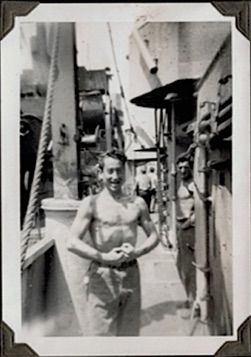
Charles F. Walsh, Jr., HA1c
H Division
We welcome Mary Starr and her dad HA1c Charles F. Walsh, Jr. aboard the USS Hendry website. She has some great photos that we will be showing on this site. Mary says, “I am sure my mom will like to see what you have done. I will send this on to her. My dad died in 1983 but I have a small photo album with little pictures. I will scan them and send to you.”
Below are pictures from Mary Starr and her Dad’s photo album. We found some surprising results!
Like Navy WAVE Edith Cramp
and Swabbie the dog
Welcome Aboard! New Personnel to the Site

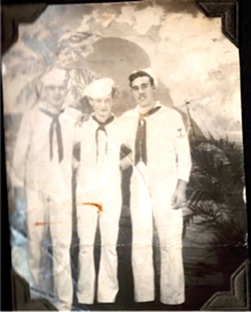
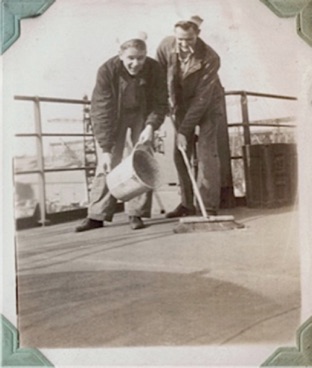
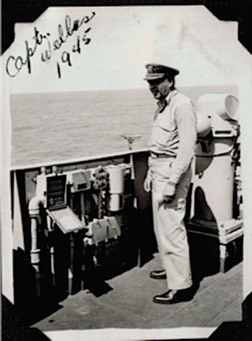
Mary Starr’s dad, Charles F. Walsh, Jr., is in the middle
This is a photo of Swabbie, a German sheppard, who apparently had full run of the Hendry. George Irvin contacted his uncle, Wilbert Bartow “Buck” Maynard, only known living crew member of the USS Hendry to see if he remembered Swabbie. Here’s what he had to say, “Does he ever remember Swabbie? Wow! He said that Swabbie was the ship’s mascot. Said Swabbie would come to his office every morning and scratch on the door. He would open the bottom half of the door and let him in, then would pet him and talk to him. Buck said he would turn his head to one side then the other as he spoke to him. He would stay a little while, then want out. They even issued him an I.D. card and Navy military tags for his collar. Swabbie made both invasions of Iwo Jima and Okinawa. Swabbie got sick often and the doctor onboard told them he needed to be off the ship. Swabbie served a couple of years onboard the Hendry almost long as the rest of the crew.... that's amazing!”
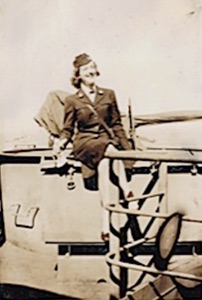
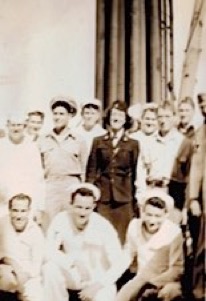
The USS Hendry made history in Dec. 1945. Shown above is Edith Cramp (Coffin). She became the first Wave to be assigned temporary sea duty aboard an active Navy vessel, the USS Hendry.
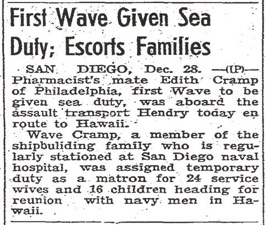
R. C. Welles, Captain, USS Hendry, Sept 1944 - Aug 1945
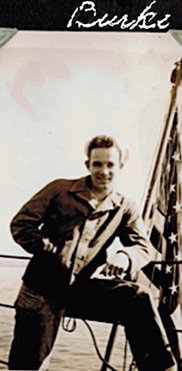
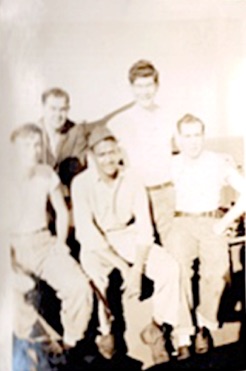
Shipmates of Charles Walsh are pictured above. Left photo, Bernard M. Burke, PhM2c. Center photo, Paul Berrisford, PhM3c; Lloyd W. Schiller, PhM2c; Walter Townsend, CK2c; Charles F Walsh, HA1c; G.H. Clark, PhM3c.
Right photo, Probably Donald L. Henn, PhM3c and Bernard M. Burke, PhM2c.
